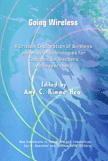Part III: Cutting the Cord—Stories on Wireless Teaching & Learning in the Composition Classroom
Part III begins with Will Hochman and Mike Palmquist's "From Desktop to Laptop: Making the Transitions to Wireless Learning in Writing Classrooms," a study of student laptop use in the classroom which "draws on and extends work done in an earlier study that assessed the impact of networked computers on teaching and learning in writing classrooms" carried out in 1998 by Palmquist and others (p. 110). In the current study, Hochman and Palmquist used instructor interviews and student surveys to measure not only how technology was used, but their attitudes towards technology and writing as a result of its use.
What they found was similar to the results of the earlier study: there is "an emphasis on student-centered pedagogy, and several [teachers] noted that they expected their students to take greater responsibility for their learning than they expected of students in traditional classrooms" (p. 126). In addition, they found that wireless classrooms made for affordances not made in a wired computer classroom:
The instructors reported in particular on the ergonomics of wireless laptops, noting the greater flexibility they allowed in designing and carrying out instruction. The instructors referred to the ease with which laptops could be moved, covers could be lowered, and laptops could be put away. (p. 127)
Here we have a study that focuses more on local issues of classroom management and practice than on the theoretical approaches taken by writers of earlier chapters, and fittingly, they leave us with more questions than answers: "For curriculum designers and teachers [...] the challenge will be investigating what has become possible and whether—and if so, how—it should be integrated into instruction" (p. 129). I say it is fitting that they leave with more questions, as this open-endedness, as demonstrated by Johnson-Eilola and Selber, is one of the more useful perspectives for a pedagogy that accepts wireless technology as part of the curriculum.
Kevin Brooks follows with a study of graduate student laptop use at North Dakota State University, where, as the WPA, he implemented a program for all graduate TAs to have access to a laptop. The most interesting finding of the study is given away in the title: "Changing the Ground of Graduate Education: Wireless Laptops Bring Stability, not Mobility, to Graduate Teaching Assistants." Stability, Brooks finds, is a result of their already having been mobile: "It was not a new mobility they had gained but rather a new file management program. Instead of having data dispersed across home and office computers, GTAs were better able to manage their files" (p. 141). In addition to the findings listed above, Brooks' chapter gives useful advice to WPAs undertaking or thinking about undertaking similar initiatives at their own universities, such as what kinds of arguments help in funding these initiatives, as well as the kind of relationships that have to be built across departments and administrative units.
Loel Kim, Susan L Popham, Emily A Thrush, Joseph G Jones, and Donna J Daulton follow with "A Profile of Students Using Wireless Technologies in a First-Year Learning Community," a case study of wireless use within a first-year learning community of nursing students at the University of Memphis. Because learning communities are meant to create a communal learning environment for incoming freshman, Kim et. al. looked at wireless use and its effect on community building among the students, as well as how frequently, where, what kind, and for what reasons students tended to use wireless technology.
What they found is that technology use "seemed to be predicated most heavily by requirements and expectations of the classroom," and they also found "some indication that even when students are from middle-class families with technology present in their homes, some students, particularly females, may be less inclined to use technology beyond the basics" (p. 169). Both findings have implications for designing and implementing wireless initiatives on college campuses, or designing pedagogies that include wireless technologies. Further, they found that in terms of community building, "Whether or not wireless access has a positive effect on learning community students' social ties is [...] unclear," as longitudinal study is necessary to measure effects on community ties.
Part III concludes with Mya Poe and Simson Garfinkel's discussion of security issues related to WPA initiatives to install wireless networks at their universities. In the article, entitled "Security and Privacy in the Wireless Classroom," Poe and Garfinkle raise key questions to consider when undertaking wireless initiatives, such as "Should the wireless network be protected or should each computer on the network be responsible for protecting itself?" and "Do the proposed policies allow for pedagogical innovation while preserving privacy and security?" (p. 181). They then go on to discuss different security protocols that can be undertaken, and the advantages and drawbacks to each.
Following this discussion, Poe and Garfinkel propose "Engaging students in the rhetorical aspects of policy" by having them participate in policy discussions related to wireless implementation, or writing about security issues and policies already in place on campus (p. 191). They argue that engaging students will "establish a dialogue with students about policies, their potentials and limitations, and their role in a democratic society" (p. 191). What this final section of the article illustrates best is one of the strengths of the articles in this book: even the most practically-oriented articles, such as those dealing with the logistics of implementation, do not ignore the ideologies embedded in technology use, that technology isn't neutral or unsituated, as the utopian determinists would have us believe, or that technology is, taken on its own, unproblematic.
